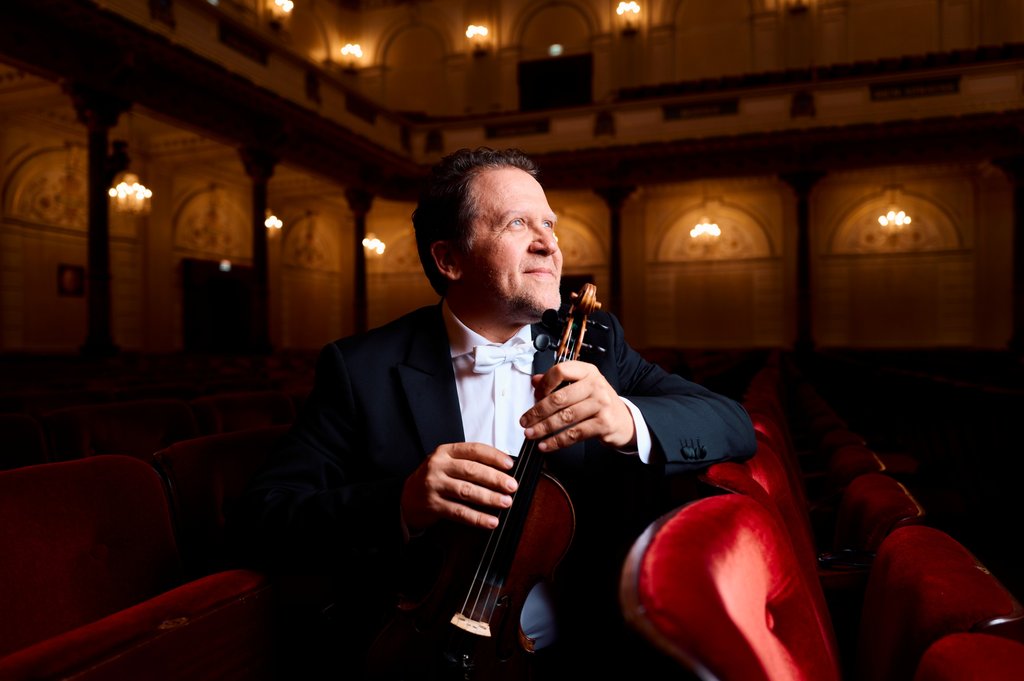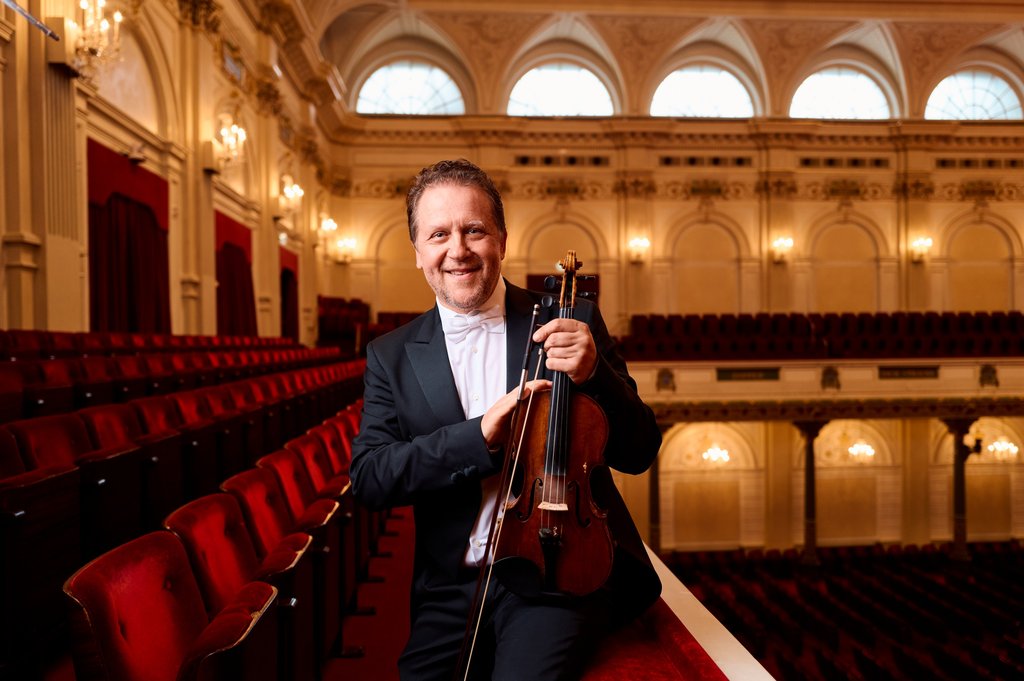Fri, Nov 7, 2025
Our concertmaster Vesko Eschkenazy was scheduled to perform the solo part in Mendelssohn’s Violin Concerto under the baton of Mariss Jansons in April 2020. But the beloved conductor sadly passed away, and next Covid brought all public life to a standstill. Now we have good news: in December Vesko will finally perform the popular work, this time with conductor Iván Fischer. Here’s what he told Preludium in 2020.

By Carine Alders - This article was published (in Dutch) in Preludium, the magazine of the Concertgebouw Orchestra and The Concertgebouw.
Felix Mendelssohn wrote a violin concerto at the request of the concertmaster of the Gewandhausorchester in Leipzig. Vesko Eschkenazy, concertmaster of the Concertgebouw Orchestra, will be performing this piece with his own orchestra.
In this concerto, Felix Mendelssohn doesn’t let the soloist waste any time. No orchestral introduction, by the second bar the violinist has fully launched into the music. ‘From the very first notes the violin plays a very lyrical, a very sensitive tone. That might well be the most beautiful moment of the entire concerto, but at the same time it’s also the most difficult,’ says Vesko Eschkenazy. ‘You start so immediately, there’s no time to build up the mood.’
Even though Eschkenazy is playing a home game, standing on the podium as a soloist is always challenging. ‘It does make a difference that I’m playing in 'my own' hall, but that also sets high expectations. In June 2018 I played my first solo performance of Mendelssohn’s Violin Concerto with the orchestra in Sofia. I’ve been playing with this orchestra for twenty years, but that was the first time we performed in the city where I was born.’
‘It was a fantastic experience, with the two worlds I both call my home coming together. That will be hard to equal. I very much wanted to play the concerto for the first time with Mariss Jansons now, but unfortunately that’s no longer possible [the conductor passed away on 1 December 2019, red.]. I was very close with Mariss, as musicians and as friends. We would talk for hours, I really miss him.’
Friendship
Another memorable friendship existed between Ferdinand David, the concertmaster of the Gewandhausorchester, and Felix Mendelssohn (1809-1847), long the chief conductor of the same orchestra. In the summer of 1838, the composer promised his friend he would write a violin concerto for him. It would, however, still take many years, and a lot of jokes and teasing between them, evidenced in their correspondence, before David premiered the Concerto with his orchestra in March 1845.
In July 1839 David wrote: ‘Take mercy now and write the violin concerto. You’re the right man for it, it will take you a mere fortnight and your reward will be eternal gratitude. But do it quickly before my fingers get stiff and the nimble violin bow starts suffering from gout.’
A week later, Mendelssohn jokingly replied in his letter: ‘That’s very kind of you to offer to saddle me with a violin concerto; I’d like nothing more than to write one for you, but honestly, that’s not a simple task. You want it to be brilliant, and how does one set about such a thing? The entire first solo must be in high E.’ The high E appears to have been a running gag between the two, because five years later he was still referring to the violin concerto as a work ‘into which a few more barrels of high E still need to be poured.’
Alert
Well he certainly succeeded in making it brilliant. Eschkenazy: ‘The virtuosity doesn’t take long to reveal itself; as a soloist you have to immediately pull out all the stops. That’s exciting, but also means it is always challenging, even if you’ve played it a million times. You have to be very alert. Every second counts, you can’t let go anywhere. And then, the three movements are contiguous. That too is a challenge, there is hardly a moment of rest anywhere in the entire work. You need to have stamina and distribute your energy wisely. After the first movement I do sometimes catch myself thinking, “two more movements to go”.’
‘About two-thirds of the way through the first movement, at the golden ratio, comes the cadenza. That’s really the most beautiful part of the whole concert. Mendelssohn introduces it very smoothly: the instrumentation is pared down while the violin plays broken chords and then you are suddenly alone, performing the solo. My goal is to play this differently every time. Mendelssohn also gives the musician that freedom. I try out different options and play with various interpretations. During the concert I then have a range of possibilities at my disposal. But I don’t know in advance which option I will choose, it all depends on the moment. For the audience it’s wonderful to see the music being created. Music is playing, not working – Mariss Jansons always insisted on “no routine”. Even if it’s only three notes, you can always vary the timing and the dynamics, and the way you connect the two.’
The cadenza was created in a collaboration between Mendelssohn and concertmaster David. In the original version that Mendelssohn left with his friend at the end of September 1844, only twelve bars of cadenza were written, but upon the advice of David, Mendelssohn completely rewrote this passage and made it three times as long. With humorous irony he writes to his friend: ‘Does the adapted and extended cadenza meet with your approval now? I am ever so much more pleased with it; but is it also playable and written out correctly? What is still missing, or still too much? The arpeggios must start immediately in tempo and continue in four parts until the tutti, are you sure this is not too tiring for the violinist?’
According to Eschkenazy, the complicated structures in Mendelssohn’s Violin Concerto provide more than enough material for a lifetime of study. ‘In the second movement, the solo violinist has a passage where he is both soloist and orchestra. And you have to make it all look and sound “easy” too…’

Old friends
As concertmaster, Vesko Eschkenazy has accompanied other soloists in this Violin Concerto. ‘That certainly gives you a greater insight into the music. To further my own musical development I also conduct. So I know the work from many angles. In the middle of the second movement there’s a passage where the violin communicates with the orchestra. The orchestra picks up the violin’s idea and completes the sentence. It’s incredibly special to play this with my orchestra, it’s like talking to old friends. Harmonically it is challenging, but I know how they will play, we can sense each other. I have played it as a soloist with other orchestras abroad and only then do you realise how good they are here. It is an uncommonly high level of quality and something that cannot be taken for granted. Anyone can play the Violin Concerto, but whether you can also play together is another matter!’
